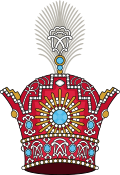Tegin
| Part of a series on |
| Imperial, royal, noble, gentry and chivalric ranks in West, Central, South Asia and North Africa |
|---|
 |

Tegin (Old Turkic: 𐱅𐰃𐰏𐰤, romanized: Tegin, also tigin, MC *dək-gɨn > Pinyin: Tèqín; Chinese:
History
[edit]History records many people carrying the title Tegin. The best known is Kül Tigin (闕特
Notable Tigins
[edit]- Alp Tigin
- Anushtakin al-Dizbari
- Anushtegin Gharchai
- Kul Tigin
- Sabuktigin
- Böritigin
- Bilgetegin
- Gazi Gümüshtigin
- Al-Taj Gümüshtegin
- Tegin Shah
- Toghtekin
- Amin Khan Aitigin
References
[edit]- ^ Ancient Coin Collecting VI: Non-Classical Cultures, by Wayne G. Sayles p.81
- ^ Sanping Chen, "Son of Heaven and Son of God: Interactions among Ancient Asiatic Cultures regarding Sacral Kingship and Theophoric Names", Journal of the Royal Asiatic Society, Third Series, Vol. 12, No. 3 (Nov., 2002), p. 296: Writing 勒 instead of
勤 is a common script error in current editions of almost all dynastic histories - ^ Maue, Dieter. "The Khüis Tolgoi inscription - signs and sounds". Academia.edu. Retrieved 4 November 2018. p. 13-14
- ^ Jiu Tangshu vol 194 upper [1] "
可 汗 者 ,猶 古 之 單 于;[...] 其子弟 謂 之 特 [勤 ] (ms.特 勒)" Tr. "the Kehan, in the past, was called Chanyu: [...] His sons and younger brothers are called Te[qin] (ms. Tele)"(in Chinese) - ^ Xin Tangshu Vol. 215 upper [2] (in Chinese) "
至 吐門,遂 強大 ,更 號 可 汗 ,猶 單 於也,[..]子弟 曰特[勤 ] (ms.特 勒)" tr. "Till Tumen, [who] has achieved strength and greatness and is now called Kehan, formerly Chanyu, [...] [his] sons and younger brothers are called Te[qin] (ms. Tele) - ^ Taskin V. S. "Materials on history of Dunhu group nomadic tribes", Moscow, 1984, p. 432
- ^ Ligeti, L (1975), Kiadó, A (ed.), Researches in Altaic languages, University of Michigan, p. 48
- ^ Sanping Chen, "Son of Heaven and Son of God: Interactions among Ancient Asiatic Cultures regarding Sacral Kingship and Theophoric Names", Journal of the Royal Asiatic Society, Third Series, Vol. 12, No. 3 (Nov., 2002), p. 296, note on misspelling
- ^ Zuev Yu. A. "The strongest tribe Esgil" //Materials of International Round Table, Almaty, 2004, p.44, ISBN 9965-699-14-3
